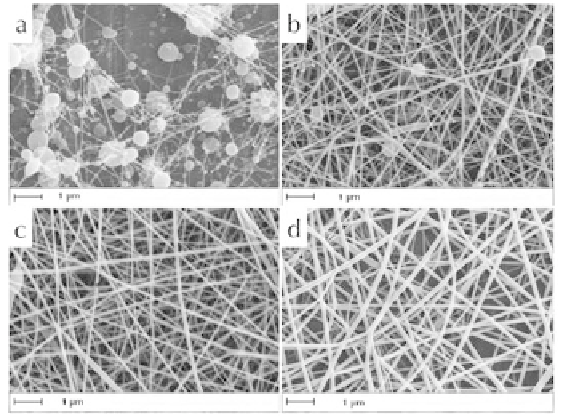Chemistry Reference
In-Depth Information
(USA). Morphology, surface texture and dimensions of the gold sputtered electrospun
nanofibers were determined using a LEO 1455VP (Germany) SEM. Fiber diameter
distribution and average fiber diameter were determined using Microstructure Mea-
surements software. Measurements of about 100 random points on the fibers were
used for determining fiber diameter distribution and the average fiber diameter.
RESULTS AND DISCUSSION
Electrospinning of Nylon 6,6 Solutions: Optimization of the Solution
Concentration
In order to optimize electrospinning solution concentration, nylon 6,6 solutions with
different concentration were electrospun in the applied voltage of 15 kV. SEM mi-
crographs of the electrospun samples are shown in Fig. 6.1. Attempt to obtain fibrous
structure from the nylon 6,6 solution with a concentration of 7% (w/v) was unsuc-
cessful; too many beads instead of nanofibers were formed. This could be attributed
to the low viscosity of the solution, which avoids the formation of a stable drop at
the tip of the needle. The concentration of the solution was then increased to 10%
(w/v). As the concentration increased, the total number of beads decreased. Increasing
concentration of the solution (12% w/v) led to lower number of beads and finally at
the concentration of 15% (w/v), no beads in the nanofibrous structure appeared and
the outcome was cylindrical, smooth, and continuous nanofibers. The average fiber
diameter for the fibers obtained using the 7%, 10%, 12%, and 15% (w/v) solutions are
58, 79, 83, and 128 nm, respectively. Viscosity is an important rheological property
to assess spinnability of the polymer solutions. Generally, there is a critical viscosity
for a solution to be electrospun; below this viscosity, chain entanglements would be
insufficient to stabilize the coulombic repulsion within the ejected jet, leading to the
formation of sprayed droplets.
Figure 6.1.
SEM micrographs of Nylon 6,6 nanofibers electrospun from different solution
concentration: (a) 7%, (b) 10%, (c) 12%, (d) 15%.

















Search WWH ::

Custom Search